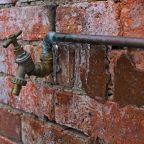
How to prevent mould in FIVE HIGH RISK areas of the home
The cold snap has finally arrived in the UK and with it, experts from MyJobQuote have warned that cases of mould in homes across the UK could soar by 400%* this autumn and winter.
Their latest research found that in 2022, searches for solutions for mould in autumn and winter rose by up to 490%. Commenting on their research, property expert Thomas Goodman from MyJobQuote shares, “Our research found that in the last year, Brits scoured the internet for solutions to mould on ceilings, mattresses, wardrobes and bathrooms, with cases increasing by up to 490% when compared to spring and summer searches. When mould takes hold in a home, it allows harmful spores in the air and can cause respiratory ailments like asthma or headaches and fatigue.”
Thankfully, MyJobQuote have shared expert tips on getting rid of mould and preventing future infestation in 5 key areas in the home.
Say goodbye to a mouldy mattress with this alcohol trick:
The common signs of a mouldy mattress are an off-white appearance with pink or fluffy black spots on the mattress that hold a pungent, musty smell. Mould on a mattress can trigger serious health problems, especially in those with weakened immune systems. Being directly laid on a mouldy mattress can contribute to nasal congestion, coughing, wheezing and other symptoms.
Not only do mattresses contend with prespiring bodies while we sleep, a lack of ventilation in a high humidity room can worsen the chance of mould on a mattress in winter. It’s important that if you spot mould on a mattress, you should remove any signs before you next sleep on it.
To do so, rubbing alcohol or isopropyl alcohol is easy to find around the house and does a good job at destroying fungus cells in mould. To remove mould, vacuum all sides of the mattress and treat visible evidence with a mix of equal parts rubbing alcohol and warm water. Once you’ve treated the area and rinsed your cloth, it’s important to go back in with the solution and scrub beyond the edges of the infected area to kill invisible spores and prevent the chance of it returning.
Leave your mattress to dry in a moist free, dry environment that is ideally in direct sunlight. Spray an upholstery disinfectant all over the mattress, let completely dry and reapply clean bed linen.
Regular maintenance is the secret to avoiding window mould:
Windows are one of the most common areas to find black mould, due to being the collecting point for moisture between a warm and cool environment. Black mould not only sits on the area surrounding windows, but also infiltrates porous materials. Wooden window frames are particularly vulnerable to structural damage from mould, as they are typically more porous and can be weakened as a result. Mould also degrades sealants around the windows, which leads to drafts, leaks and even more mould.
To get rid of mould near windows, use a mixture of one part bleach to three parts water in a bowl. When wearing gloves, use an abrasive sponge and scrub away any visible signs of mould in the window area. For harder to reach areas such as corners and sealants, use an old toothbrush wet with some bleach solution to get rid of all spores.
To prevent future mould returning, keep the trickle vent open at the top of the window to ensure proper ventilation and regularly clean the area to avoid a damp environment. You can also consider applying a mould resistant primer to the window frame for additional protection, which acts as a sealant.
Avoid hanging towels in wet bathrooms to prevent mould:
The bathroom is often the most humid room in the house, causing a higher chance of mould and mildew to appear than any other room. Lingering moisture with little ventilation in bathrooms can cause mould spores to crop up, particularly in areas around taps and the edge of baths or showers.
You can treat mould in bathrooms by using mould specific products from your local supermarket, rubbing alcohol or if you’re looking for something more natural, white vinegar. In cases of stubborn mould, soak a cloth or cotton pad in the product and leave to sit against the area for an hour before removing and wiping clean.
To prevent future build up, it’s recommended to give the area around your bath or shower a thorough wipe with a clean cloth after you’ve used it. Ensure the rest of the bathroom has proper ventilation by opening the door, opening a window or turning on a ventilation fan if you have one.
In autumn and winter, heat your bathroom throughout the day as this will dry out remaining moisture in the air. As another preventative measure, avoid hanging wet laundry in a cold wet room like the bathroom, as this can cause mould spores to build on towels. Instead, hang where they’re most likely to dry.
Mould in wet appliances means lingering spores on crockery and clothes:
Wet appliances such as our washing machine and dishwasher typically see a build up of mould if not regularly cleaned. Dishwashers are dark and damp, making the perfect breeding ground for mould to grow. Despite dishes coming out clean, hidden germs may be preventing your tableware from coming out properly sanitised. To thoroughly clean your dishwasher of mould spores, take out any trays and soak in hot soapy water. After soaking for a few minutes, scrub thoroughly with a sponge or old toothbrush.
As for the rest of the dishwasher, pay close attention to the seal when cleaning as mould can erode it and may mean a need for repair. To kill remaining mould, place a dishwasher safe cup of white vinegar on the top shelf and run a hot cycle. When finished, leave the door open to properly dry before putting back any cutlery holders.
Washing machines are also vulnerable to build up, particularly around the rubber seal and in the product drawer. Before cleaning the drum, take a scrubbing brush and clean inside and around the seal with white vinegar or a mould cleaner from the supermarket. Soak your drawer in clean soapy water and take a scrubbing brush and a cleaning solution and thoroughly clean the drawer gap before returning it.
As for the drum, run a quick cycle on the hottest wash with white vinegar to kill remaining mould spores. To minimise future build up, keep the drum door open after a wash and regularly clean the drawer as this enables ventilation into the washing machine.
Mould on ceilings require professional assistance:
Black mould on walls is often a sign of a more serious problem than the seasonal build up of condensation. While it is from a lack of ventilation in the home which results in high humidity, it’s a sign that the air in your home contains too much moisture which could be from an underlying damp problem. Due to being a clearer indicator of a damp problem, this must be properly treated to prevent future mould from returning.
A professional damp surveyor will take notes of any issues, look for the source of the mould and include recommendations for repair.













